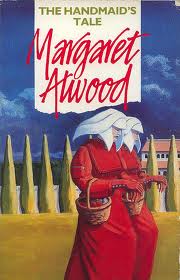The menstrual cycle has been of interest to novelists from time to time and some of their work has received critical attention by scholars, most notably in Dana Medoro’s Bleeding in America, a seminal study that assesses the menstrual elements in the novels of Faulkner, Pynchon, and Morrison (previously reviewed here). But perhaps the novel that is devoted most completely to the social, political, religious, cultural and economic impact of disruptions in the healthy functioning of the menstrual cycle is Margaret Atwood’s 1985 depiction of a menstrual dystopia, The Handmaid’s Tale.
 Now, 27 years after its publication, the novel resonates with relevance to the current circumstances of our lives. As such, it deserves recognition along with those other prescient novels of a dysfunctional future, Fahrenheit 451, Brave New World, and 1984.
Now, 27 years after its publication, the novel resonates with relevance to the current circumstances of our lives. As such, it deserves recognition along with those other prescient novels of a dysfunctional future, Fahrenheit 451, Brave New World, and 1984.
Atwood envisions a world in which, due to a combination of environmental disasters, most women have become incapable of conceiving, leading to the creation of a cadre of “handmaids” who still have normal menstrual cycles and who are assigned to the leaders (“Commanders”) of the nation to bear them children who are immediately turned over to their infertile wives. They enact a weird form of surrogacy patterned after the story in Genesis of Rachel’s handmaid having sex with Jacob so that Rachel can have a child. The handmaids (who do not have names of their own but instead are referred to as possessions of their Commanders with the prefix “of,” as in OfFred) have sex by lying between the legs of the Commander’s wife so as to pretend that the congress is “normal.” The fiction is continued when a birth occurs with the wife simulating labor surrounded by other wives while the handmaid delivers the child elsewhere.
The novel is prescient on many levels. Our own concerns with the potential effects of environmental contamination on reproduction are strikingly anticipated:
“The air got too full, once, of chemicals, rays, radiation, the water swarmed with toxic molecules, all of that takes years to clean up, and meanwhile they creep into your body, camp out in your fatty cells. . . . Women took medicines, pills, men sprayed trees, cows ate grass, all that souped-up piss flowed into the rivers. Not to mention the exploding atomic power plants. . . and the mutant strain of syphilis no mold could touch.” (143-144)
As a result, the birth rate plummets far below replacement level, schools are closed for lack of children and fertility becomes a rare commodity that is carefully controlled as women still capable of conceiving are doled out as special benefits to the rulers of the state. All of this occurs in the context of a culture of religious fanaticism with a full complement of hypocrisy and brutality common to extremes of any stripe.
Key scenes are built around gynecological exams, menstrual anxiety, failed attempts at impregnation: all aspects of cycle management. Every moment of the narrator’s life centers on her identity as a potential producer: “Each month I watch for blood, fearfully, for when it comes it means failure. I have failed once again to fulfill the expectations of others, which have become my own.” (95)
As we experience today’s resurgence of efforts to control or limit women’s reproductive options and the tangled skein of regulations, insurance restrictions, religious assertions, and political posturing, The Handmaid’s Tale makes for timely reading.


Right on, David! I was *just* saying this the other day after another one of Santorum’s hate-speeches — “we’re living in The Handmaid’s Tale”. Nice commentary.
Efforts to control women’s access to reproductive options are a serious concern, but let’s not forget why this happens in The Handmaid’s Tale.
As your quote references, it is the catastrophic drop in fertility that leads to the emergence of controls. The menstrual cycle is failing, shutting down in many women. Only the healthiest, it seems, have survived the onslaught of environmental pollution, drugs and mutant strains of STIs. Fertile women are forced into reproductive slavery.
Infertility is on the rise. Simple things like poor nutrition and lifestyle choices contribute to infertility. Chlamydia, the most common and treatable of STIs, is causing infertility in young women. Endocrine disruptors found in the environment and products of all types (including cosmetics, personal care products and plastics), as well as hormonal contraception, impact fertility.
If we are seeing such efforts in the U.S. to limit access to reproductive options at this point, just think what might happen should infertility, the rates of which are rising in women under 30, becomes epidemic?
The importance of protecting women’s fertility is an important take-away from The Handmaid’s Tale.
Atwood’s more recent novels expand on the dystopian not-to-distant-future with genetic engineering gone out of control, food scarcity, and militarized security measures. All her work is on the grim side (with odd humorous jabs), but her more recent stories (since Handmaids Tale) are far more interesting and socially acute compared to her early work which was more self reflective.
I agree – excellent and timely article…. I have also been referring to Atwood’s book in relationship to the HPV vaccines that are affecting adolescent’s girl’s endocrine system functioning. Thank you David.